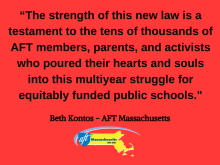Tens of thousands of public-school advocates across Massachusetts let out a collective cheer after Governor Charlie Baker signed the landmark Student Opportunity Act (SOA) into law at a signing ceremony at English High School in Boston on November 26. The new law commits the state to achieving equitably funded public schools over a seven-year span, promising billions in additional state aid over that period.

The final signed law makes an extraordinary, once-in-a-generation investment in K-12 public education. Once fully phased in, it will deliver $1.5 billion in additional annual state aid to local public schools, with the bulk of those resources going to the neediest schools and students. Many schools and communities will begin to see the benefits of the law as soon as the next school year, the first year of implementation.
The biggest driver of the funding increases are changes made by the law to the state’s antiquated foundation budget formula, which determines how much state school aid—or “Chapter 70 aid”—local communities need to provide students with an adequate education. The law’s changes address all four major recommendations of the Foundation Budget Review Commission, the bipartisan group that studied the funding formula four years ago: more resources for educating students who have disabilities, are English learners, and/or are from low-income families; and adequately funding the rising cost of health insurance for staff and retirees.
The funding formula changes are expected to generate an increase of $1.4 billion annually in Chapter 70 aid to local schools once the law is fully phased in. By design, and as a result of the advocacy of AFT Massachusetts and coalition allies, low-wealth communities serving high numbers of low-income students will receive the most money under the updated formula.
In addition to dramatically increasing Chapter 70 aid, the SOA:
- Expands the special education circuit breaker program, which reimburses districts for extraordinary special education costs, to include transportation costs in addition to instructional costs, phased in over four years at an estimated annual cost of $90 million.
- Fully funds charter tuition reimbursements, which provide transitional aid to help districts when students leave to attend charter schools, within a three-year timetable.
- Increases the annual spending cap for Massachusetts School Building Authority (MSBA) projects by $200 million to $800 million.
The version of the SOA signed by Baker into law is identical to the one passed by the Legislature on November 20. That was a compromise bill that emerged from a House-Senate conference committee charged with ironing out modest policy differences between the version of SOA passed by the Senate on Oct. 3 and the version passed by the House on Oct 23.
The final law requires districts to develop three-year plans outlining how new funds will be spent to address educational disparities. The plans are to be developed by the superintendent, who must consider input and recommendations from parents, educators in the district, and other relevant community stakeholders. The plans must then be reviewed by the state commissioner of education, who can require districts to amend any plans “deemed not to conform with the requirements” in the bill that spell out what the plans must include.
“We were happy to see that the bill requires district plans to consider input from parents and educators—something we fought for,” said Kontos. “On the state review piece, it’s a satisfactory compromise when you consider the totality of the bill. Still, we will need to remain vigilant and engaged during implementation to ensure that parent and educator voices are respected, and to make sure that new funds are spent on the correct priorities—direct supports and services for students.”
Overall, public-school advocates across the state, including AFT MA’s coalition allies, are thrilled that everybody’s hard work over the last three years has resulted in such a strong final law. Upon enactment of the SOA, Massachusetts will likely have the most progressive school funding system in the nation, building on its national reputation as a trailblazer for equity in public education. That’s because the bill directs the lion’s share of resources to communities with the highest concentrations of low-income students.
“The Student Opportunity Act will deliver increased state funding to every district, but the greatest increases, rightfully, will go to low-income districts whose students have the greatest needs,” said Kontos. “That means that students of all backgrounds will finally be able to enjoy the benefits—everything from smaller classes and additional counselors to up-to-date classroom supplies and more art, music, and enrichment—that their peers in wealthier districts take for granted. It’s a true game-changer for low-income students and their communities.”
The final conference-committee bill passed unanimously by the House and Senate on November 20 and signed into law by the governor on November 26 can be found at the Legislature’s website: https://malegislature.gov/Bills/191/S2412.
AFT Massachusetts will provide much more information about the new law and what it means for local communities in the weeks and months ahead.
